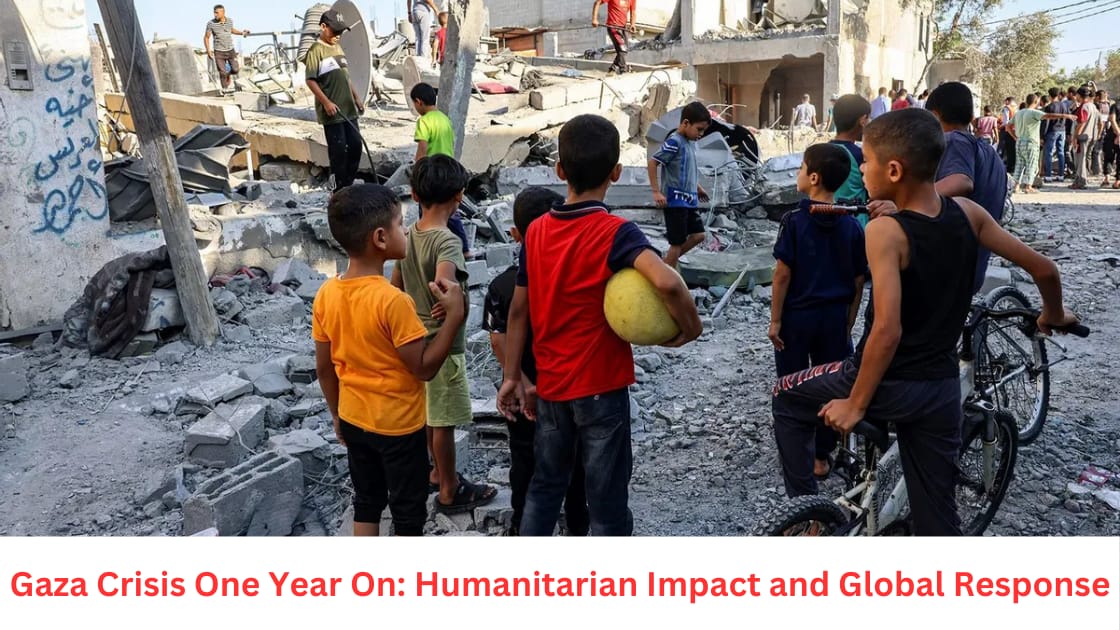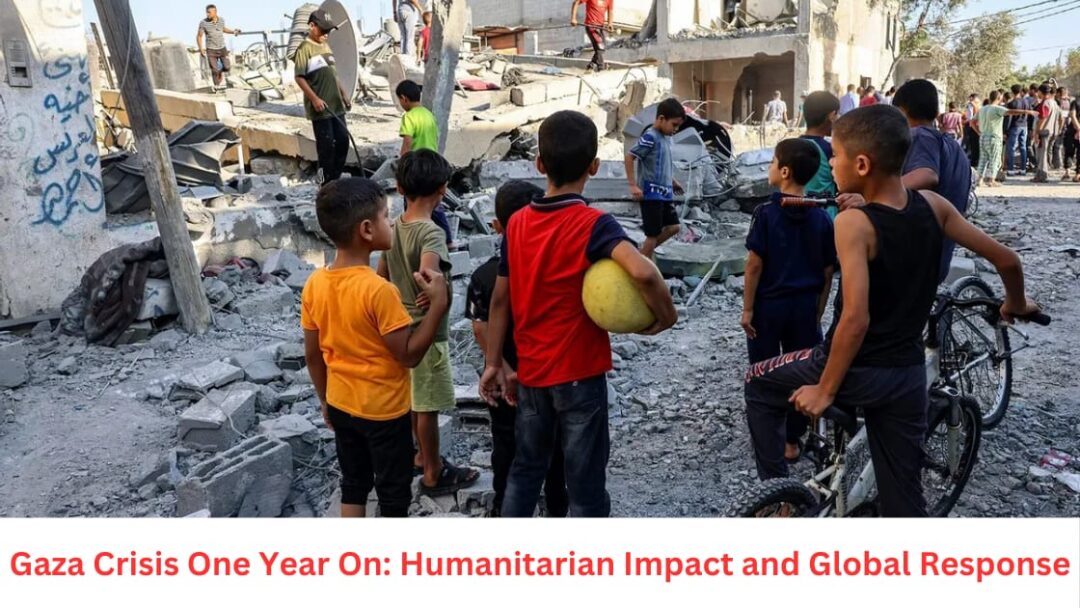Physical Address
304 North Cardinal St.
Dorchester Center, MA 02124

One year after the devastating Gaza Crisis One Year On conflict, the region remains at the epicenter of a severe humanitarian crisis. The 2023 escalation between Israel and Gaza’s militant factions resulted in thousands of deaths, extensive infrastructural damage, and immense suffering for the Palestinian civilian population.
International efforts to alleviate the situation continue, but the political complexities and protracted nature of the conflict have made effective resolution elusive. This article provides a comprehensive analysis of the humanitarian impact on Gaza, the international response, and the broader implications for the region and global politics.
The 2023 Gaza Crisis One Year On conflict led to an alarming number of casualties. According to reports from the United Nations (UN) and other humanitarian agencies, over 5,000 Palestinians were killed, including women and children. Many more were injured, often with life-altering wounds. The violence resulted in widespread displacement, with an estimated 500,000 people forced to flee their homes due to airstrikes and ground incursions.
Gaza Crisis One Year On humanitarian crisis already overcrowded urban areas saw further strain as displaced families sought shelter in schools, hospitals, and temporary relief camps. However, these shelters were insufficient to accommodate the large influx, resulting in unsanitary conditions and a heightened risk of disease outbreaks.
The bombardment of Gaza Crisis One Year On caused extensive damage to essential infrastructure, including homes, schools, hospitals, and power plants. Gaza’s Humanitarian crisis has already fragile healthcare system was overwhelmed, and medical facilities faced severe shortages of equipment, supplies, and electricity. The destruction of power plants led to widespread power outages, disrupting water supply and sanitation services, further complicating relief efforts.
The rebuilding process has been painfully slow, with limited construction materials allowed into the Gaza Strip due to Israel’s ongoing blockade. Essential services like healthcare, education, and access to clean water remain severely compromised.
The conflict exacerbated Gaza Crisis One Year On longstanding economic woes. The unemployment rate, which was already one of the highest in the world, surged to nearly 50%. Many businesses were destroyed, and the agricultural sector, a vital source of income for many families, suffered due to damaged farmland and infrastructure. The blockade and trade restrictions imposed by Israel have made it difficult for goods to enter or leave the territory, hampering any attempts at economic recovery.
This economic collapse has led to increased food insecurity, with over 70% of Gaza Crisis One Year On population now relying on humanitarian aid to survive. According to the World Food Programme (WFP), many families in Gaza are living on less than one meal a day, and malnutrition rates are rising, particularly among children.
In addition to physical destruction, the psychological toll on Gaza Crisis One Year On population has been severe. Many residents, especially children, have experienced trauma from the violence and the loss of loved ones. The constant threat of airstrikes and the destruction of homes and neighborhoods have led to widespread mental health issues, including post-traumatic stress disorder (PTSD), anxiety, and depression.
Mental health services in Gaza Crisis One Year On are limited, and the ongoing blockade restricts access to external support. Many organizations working to provide psychological aid have reported overwhelming demand for their services, with the needs far outstripping available resources.
The United Nations (UN) has been at the forefront of the international humanitarian response, but its efforts have been hampered by the lack of political resolution. The UN Relief and Works Agency (UNRWA), responsible for aiding Palestinian refugees, has faced funding shortages, complicating its ability to provide critical services such as food distribution, healthcare, and education.
Despite these challenges, UNRWA and other international agencies like the International Committee of the Red Cross (ICRC) and Doctors Without Borders (Médecins Sans Frontières, or MSF) have been working tirelessly to address the Gaza humanitarian crisis needs. They have provided medical supplies, food aid, and emergency shelter. However, the scale of the crisis is such that these efforts, while crucial, are insufficient to meet the growing demands.
Several countries and international organizations have pledged financial aid for the reconstruction of Gaza. The European Union, the United States, Qatar, and Egypt have been significant contributors. Qatar, in particular, has played a key role, committing millions to rebuild homes and infrastructure, while Egypt has helped mediate ceasefires and allowed aid convoys into Gaza Crisis One Year On through the Rafah crossing.
However, much of the promised aid has been delayed or fallen short due to political disagreements and logistical challenges. The continued Israeli blockade has also restricted the flow of materials necessary for reconstruction, leading to frustration among Gaza Crisis One Year On population and international donors alike.
Diplomatic efforts, primarily led by Egypt and Qatar, have succeeded in brokering temporary ceasefires throughout the past year, helping to reduce the intensity of the conflict. However, these ceasefires have been fragile, often breaking down due to provocations on both sides. The broader peace process remains stalled, with no significant breakthroughs toward a long-term resolution.
The international community, including the United Nations, has repeatedly called for renewed peace talks, but the deep-rooted political divisions between Israel and Hamas, along with broader regional dynamics, have made negotiations exceedingly difficult. The U.S., traditionally a key mediator, has faced criticism for its perceived lack of engagement in pushing for a sustainable peace deal.
The Gaza conflict has further entrenched divisions between Israelis and Palestinians. In Israel, the conflict has fueled hardline sentiments, with many viewing military action as the only means of ensuring security from rocket attacks. Meanwhile, in Gaza Crisis One Year On Humanitarian crisis and the West Bank, the destruction has deepened anger and despair, particularly among the youth who see little hope for a peaceful future.
The conflict has also strained relations between the Palestinian Authority (PA) in the West Bank and Hamas in Gaza Crisis One Year On. Efforts to form a unified Palestinian front have stalled, with each side accusing the other of undermining Palestinian interests.

The Gaza crisis has had significant ripple effects across the Middle East. Countries like Egypt, Jordan, and Qatar have been active in trying to mediate the conflict and provide humanitarian aid. However, these efforts are complicated by the broader regional rivalries and the shifting dynamics of Middle Eastern geopolitics, particularly the normalization of relations between Israel and several Arab states under the Abraham Accords.
Iran, a key backer of Hamas, has used the conflict to bolster its influence in the region, providing military and financial support to Gaza Crisis One Year On militant factions. This has led to heightened tensions between Iran and Israel, contributing to a volatile regional security environment.
The international community’s response to the Gaza Crisis One Year On humanitarian crisis has been mixed. While many countries have condemned the violence and called for a cessation of hostilities, divisions remain over the best path forward. The conflict has reignited debates about international law, with accusations of war crimes leveled at both Israel and Hamas.
Human rights organizations like Amnesty International and Human Rights Watch have called for independent investigations into alleged violations of international humanitarian law, including the targeting of civilians and the destruction of civilian infrastructure. These calls have added to the pressure on the international community to address the situation, but concrete actions have been limited.
One year after the Gaza conflict, the humanitarian crisis situation remains dire, with little progress toward a long-term resolution. The people of Gaza Crisis One Year On continue to suffer from the effects of war, economic collapse, and political isolation, while the international community struggles to provide adequate relief and mediate a sustainable peace process. The ongoing blockade, regional rivalries, and the complex political dynamics between Israel and Hamas further complicate efforts to rebuild and stabilize the region.
Looking ahead, the world must prioritize humanitarian aid, push for renewed diplomatic efforts, and address the root causes of the conflict. Without meaningful international intervention and a commitment to peace, the cycle of violence and suffering is likely to continue, with devastating consequences for the people of Gaza and the broader Middle East.
The conflict was triggered by a combination of political tensions, rocket attacks from Gaza Crisis One Year On, and military responses by Israel.
Over 5,000 Palestinians were killed, and approximately 500,000 were displaced during the conflict.
Gaza Crisis One Year On infrastructure remains severely damaged, with slow reconstruction efforts due to the blockade and lack of resources.
Organizations like the UN, WFP, and ICRC are providing critical humanitarian aid, including food, medical supplies, and shelter.
The Israeli blockade has restricted the flow of goods, exacerbating economic hardship and slowing reconstruction efforts.
Peace talks remain stalled, with no significant progress toward a long-term resolution.
Qatar, Egypt, the European Union, and the United States have all pledged aid for Gaza’s reconstruction.
The conflict has deepened divisions, with little hope for reconciliation in the near term.
Iran has provided support to Hamas, further complicating the regional security environment.
Increased humanitarian aid, diplomatic efforts for peace, and easing of the blockade are essential for improving conditions in Gaza.